The Skylake Core i3 (51W) CPU Review: i3-6320, i3-6300 and i3-6100 Tested
by Ian Cutress on August 8, 2016 9:00 AM ESTOffice Performance
All of our benchmark results can also be found in our benchmark engine, Bench.
Agisoft Photoscan – 2D to 3D Image Manipulation: link
Agisoft Photoscan creates 3D models from 2D images, a process which is very computationally expensive. The algorithm is split into four distinct phases, and different phases of the model reconstruction require either fast memory, fast IPC, more cores, or even OpenCL compute devices to hand. Agisoft supplied us with a special version of the software to script the process, where we take 50 images of a stately home and convert it into a medium quality model. This benchmark typically takes around 15-20 minutes on a high end PC on the CPU alone, with GPUs reducing the time.
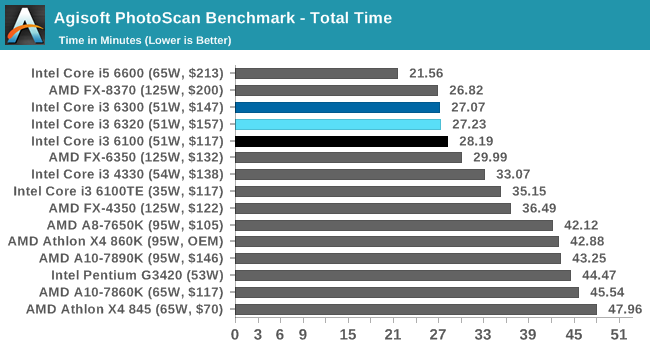
The different stages of Photoscan have different preferences for frequency and threads, but all the results are in Bench. In this case having threads matters, with the old 8-thread FX CPU barely getting ahead of the Core i3 parts. The i5 takes the lead, showing that having physical cores helps with cache management. This is further reinforced by our results staircase, which put the i3-6320 and i3-6300 at roughly equal timings but the i3-6100 almost 4% behind.
Cinebench R15
Cinebench is a benchmark based around Cinema 4D, and is fairly well known among enthusiasts for stressing the CPU for a provided workload. Results are given as a score, where higher is better.
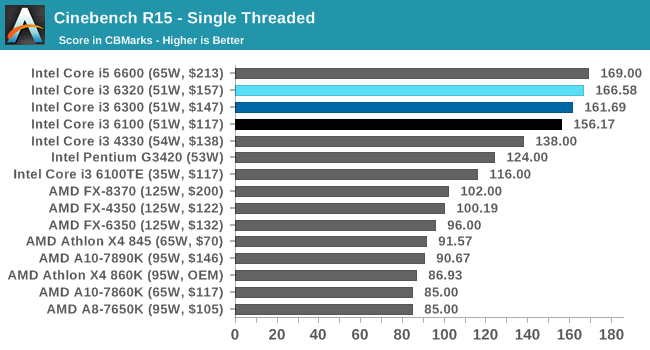
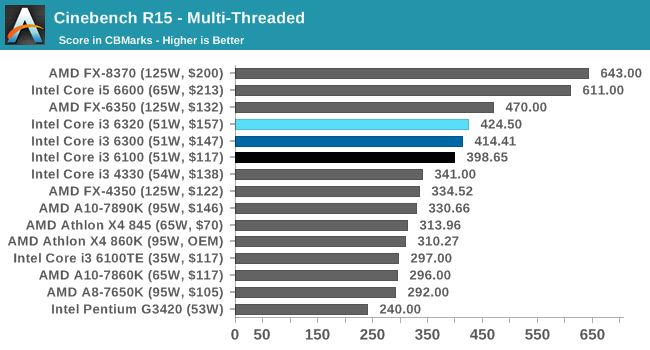
Cinebench eats threads, high IPC and high frequency for breakfast. In the single thread test, the high Intel IPC shines through, and our i3 parts sit in unison with AMD behind by up to 40%. In multithreaded land, the 6/8 thread FX processors go ahead of the i3s as expected, and our staircase slightly deviates for the i3-6100 showing that L3 cache creep is slowly coming in.
HandBrake v0.9.9: link
For HandBrake, we take two videos (a 2h20 640x266 DVD rip and a 10min double UHD 3840x4320 animation short) and convert them to x264 format in an MP4 container. Results are given in terms of the frames per second processed, and HandBrake uses as many threads as possible.
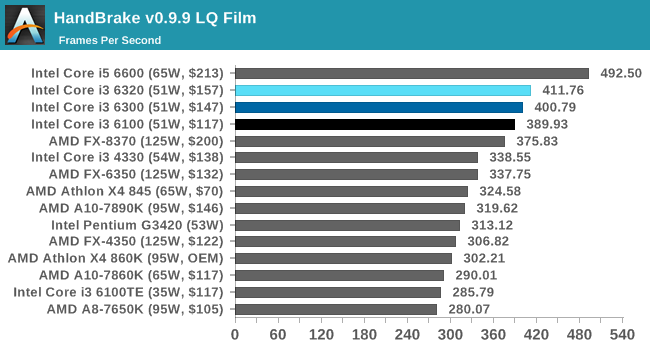
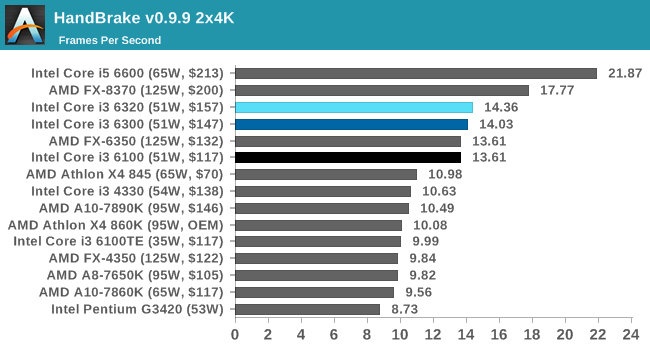
The high IPC of the Skylake parts makes a difference for the smaller frame conversion, while threads come into play for the larger resolution frames. In both cases, the regular staircase shows a lack of issues with the L3 cache differences, but it is interesting to see the X4 845 hot on the heels for the high resolution frames despite its cache arrangement. The FX-6350 sits on par with the i3-6100, showcasing the difference between a six-thread much older processor and a four thread latest process part.
Hybrid x265
Hybrid is a new benchmark, where we take a 4K 1500 frame video and convert it into an x265 format without audio. Results are given in frames per second.
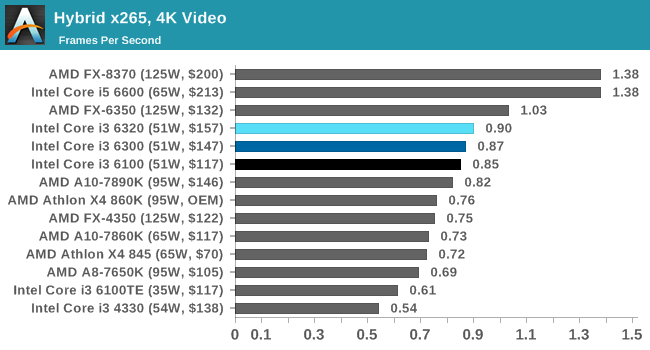
Hybrid is similar to HandBrake, and we again have a regular staircase.










94 Comments
View All Comments
Ratman6161 - Monday, August 8, 2016 - link
I don't understand your point. Did you note how many of the tests where the i3's (sometimes just the 6320 and sometimes all of them) beat the i5? Also look at certain gaming tests where an i3 with a better graphics card beats an i5 with a lesser graphics card...i.e. if you save $100 on the CPU and put that towords the graphics instead, you sometimes come out ahead overall.Finally, I know plenty of people who are just using their PC for web surfing, email, MS Office, etc where they would not notice any difference between an i3-6100 and an i5-6600K other than the fact that it cost almost $100 more. Sometimes good enough is good enough and thats where the i3 comes in.
extide - Monday, August 8, 2016 - link
Yeah, the i3's sometimes beat the i5's because when moving from the top end i3 to the bottom end i5 you lose quite a bit of frequency, but you gain two physical cores. So, if something is very lightly threaded then it may perform better on the i3.beginner99 - Tuesday, August 9, 2016 - link
True but for the mentioned usage you can step down to a Pentium or even Celeron and save even more and not notice much of a difference.BillBear - Sunday, August 14, 2016 - link
I agree. If Android can manage to leverage many small ARM cores for common tasks like web browsing, there is no excuse for Microsoft not being able to manage the same feat on Windows.http://www.anandtech.com/show/9518/the-mobile-cpu-...
xenol - Monday, August 8, 2016 - link
Please, do more lower-end CPU reviews! This data helps me understand how software and hardware play together more and more.To those thinking that it's sad that performance hasn't really increased in the past few years, maybe this is more of a sign that games are becoming efficient. If anything, this means your hardware will go a lot longer than before. Think about it, if the i5-2500K is still a viable CPU, think about how long an i5-6600K will last.
Philotech - Monday, August 8, 2016 - link
I'd love to see the same comparison for the mobile variants of the i3/i5 chips, in particular the 15W variants suitable for ultrabooks and MacBook Pros.Looks like for desktops, as a mainstream user there is no need to look beyond the i3. How about mobile? Looking at Intel's ARK database, there aren't that many 15w i3s (one, actually, 6100U), but a few i5s (four).
dave_the_nerd - Monday, August 8, 2016 - link
That seems tough - since they're soldering into the chassis, and different cooling can result in throttling and very different performance numbers even from the same chips. It'd be really hard to make a fair CPU-to-CPU comparison.Philotech - Monday, August 8, 2016 - link
Hm, you're right probably. Seeing how small the differences between the desktop i3s and i5 is, I'm wondering if it makes any sense at all to judge a laptop or ultrabook by its CPU, in particular taking into account your point, i.e. that probably cooling (and selecting a higher or lower TDP by the manufacturer) makes much more of a difference than the CPU model.extide - Monday, August 8, 2016 - link
Well, in the mobile chips the segmentation is different. In the desktop world going from i3 to i5 you gain two cores, lose hyper threading, and gain turbo boost.In the mobile chips everything has hyper threading. Going from i3 to i5 gains you turbo boost on a mobile chip and that can be pretty significant, because on those really low TDP chips they tend to have a pretty low base speed but the ones that can boost can usually boost up quite a bit. Going to an i7 in the 15w chips add's a bit more clockspeed and you will typically move from 3MB of L3 to 4MB of L3. The best value are the i5's in the mobile world because turbo boost helps a lot, but moving to an i7 with 4MB of L3 doesnt really gain that much performance, and can be pretty costly.
So, you can't really use these results to judge the differences between mobile i3's and i5's because they are quite different.
slickr - Monday, August 8, 2016 - link
I'm waiting for AMD's Zen CPU's before I upgrade my CPU. I'm running an older I5 3330, but so far nothing is really significantly faster for the same price I bought it at the time(180 euros). Especially in games the difference seems negligible and mostly comes down to GPU.So I'm waiting on Zen as my next likely upgrade.